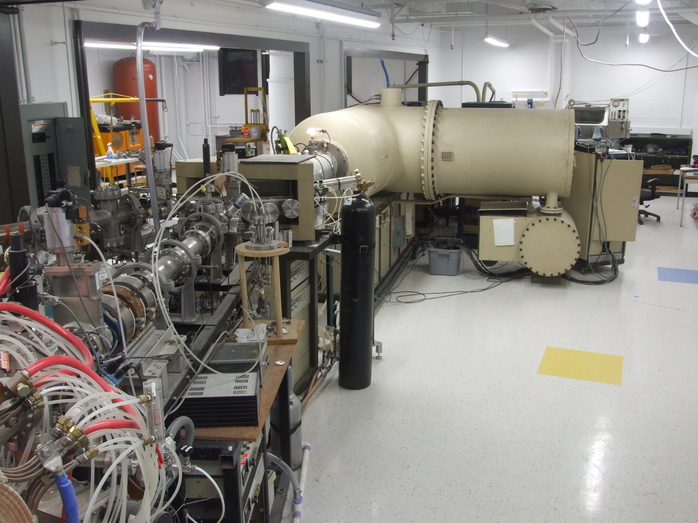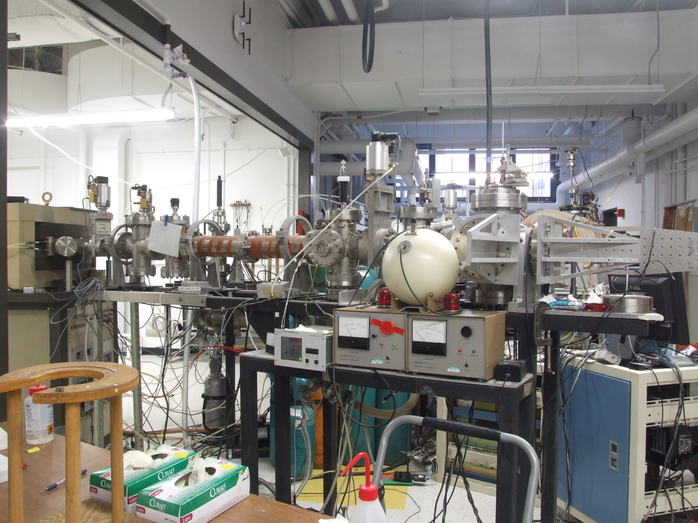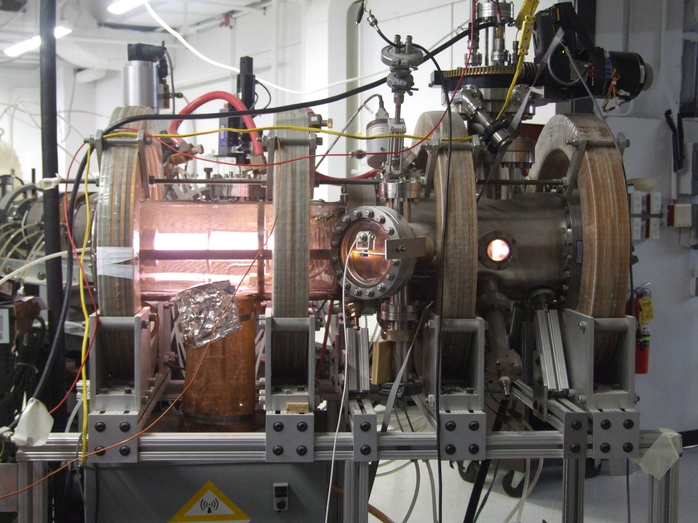





The workhorse of the Cambridge Laboratory of Accelerator Studies of Surfaces is the General Ionex 1.7 MV tandem ion accelerator, or Tandetron for short. The Tandetron is a completely solid-state ion accelerator (i.e. no moving parts) based on a parallel-fed cascade generator with a Cockroft-Walton voltage multiplier. The terminal control electronics use a generating voltmeter for feedback and keep the terminal ripple down to a few kV, ensuring well defined ion beam energies for confident interrogation of surfaces. We have pushed the terminal past it’s nominal value with appropriate high voltage conditioning to a maximum value of 1.788 MV, limited by the control electronics. The highest terminal potential we have used for research was 1.75 MV for several hours of continuous use. The Tandetron uses N2 gas for electron stripping at the terminal. Depending on the electron stripping cross sections, various charge states emerge at the high energy end of the accelerator. A selector magnet at the high-energy end, we can choose which charge state beam we would like, so we have the ability to use ion beams that are +4 or +5 ions. This allows us to utilize beams with energies of up to 10.5 MeV. The accelerator can operate with relatively high beam currents (<100 uA) for greater flexibility with IBA at the target.
On the low energy end of the accelerator, we use one of two ion sources. For many ion beams of interest, we use the National Electrostatics Corporation Source of Negative Ions by Cesium Sputter (SNICS). This source utilizes a solid cathode to produce ion beams, so you ion beam species is determined by the material or compound used for the cathode tip. We mainly use H, Li, O, Si, Cu, and Au beams from this source for research purposes, but thanks to the variability of the cathode material, the SNICS source can produce an ion beam from almost any element from H to Pb. The second ion source we use is the National Electrostatics Corporation RF Charge Exchange Negative ion source, also called an Alphatross source. This ion source uses a RF generated plasma to extract ions though a Rubidium charge exchange chamber to produce negative ions from gaseous species. 4He is most commonly used in this source but H can also be run in the Alphatross. For more specialized experiments, Helium-3 can be used in this source. 3He can induce a wide range of nuclear reactions that are of interest to our research since it can discriminate between isotopes of a single element. It also has resonant cross-sections for some reactions yielding high-quality depth profiles of specific elements and isotopes. Having both ion sources gives our research lab the ability to make almost any ion beam desired and allows us to participate in a wide spectrum of scientific fields.
At the high energy side of the accelerator, we have two beam lines currently in use, one with a multi-purpose high vacuum target chamber and one with the more specialized plasma-surface interaction experiment, DIONISOS. Both target chambers have the ability to perform the full range of ion beam analysis techniques for material analysis. The high vacuum beam line has the additional ability to allow the ion beam to be brought out into atmosphere through a 7.5 um Kapton window. This capability allows us to perform Particle Induced X-ray and Gamma ray Emission (PIXE and PIGE) analyses on samples that are not easily mountable, vacuum non-compatible, or too large for the high vacuum target chamber. Also, the high vacuum beam line has sequential apertures to ensure the alignment of the ion beam so that ion channeling may be performed on crystalline targets. Ion channeling allows for greater sensitivity in measuring and quantifying lattice defect sites in crystalline materials. The beam line is equipped with electrostatic steerer plates in both the X and Y directions. These steerer plates can be connected to programmable high voltage supplies allowing the ion beam spot (typically 1-3 mm diameter spot) to be raster scanned over a large area (~30 x 30 mm) for uniform implantation or irradiation. The beam line that terminates into the DIONISOS experimental chamber has some unique modifications to accommodate having a low-pressure helicon plasma source mounted on a high vacuum beam line. An 8 mm aperture flange is mounted to allow for differential pumping of the beam line when the plasma source is running. Down stream from the aperture The pressure in this beam line can be vary from 10-6 torr to 10-3 torr by differential pumping with various gases such as H, D, He, Ne, Ar, and Kr. Upstream of the aperture the pressure is maintained at 10-5 torr or better even during plasma operations. There are no apertures for beam alignment or shaping so electrostatic steerer plates down stream from the pumping aperture are used to position the beam spot and an extra set of quadrupole magnets are mounted on the beam line for beam spot focusing capabilities. Beam profile monitors measure current pick up on a spinning helical wire, which is translated into a profile of the beam shape in the X and Y directions as well as the beam’s position relative to the center of the beam line. Beam profile monitors and faraday cups are positioned upstream and down stream of the pumping aperture so that the beam shape, position and current can be determined as it travels down the beamline. All of these features in the beamline enable the main capability of DIONISOS, which is the ability to simultaneously irradiate a target with a high flux (≤ 1022 m-2s-1) of plasma ions and high-energy ions from the accelerator. This can allow for real-time irradiation of targets during plasma exposure or real-time material analysis of targets under plasma bombardment using standard ion beam analysis techniques. For more details on DIONISOS, click here.